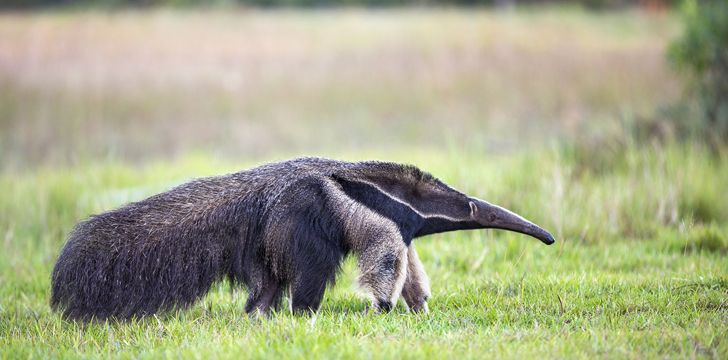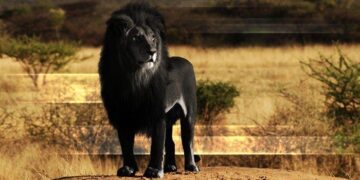My favorite animal of all time is a weird one, and if you haven’t guessed by now, it’s the Giant Anteater.
With an impressively long tongue and a strange-looking pointy nose, the Giant Anteater is the coolest mammal you probably knew nothing about!
Here are 30 interesting facts about the Giant Anteater that you didn’t know:
Let’s start with the obvious, what it’s famous for, its tongue. The tongue of the Giant Anteater is about 2 feet (61 cm) long. That’s longer than your pet cat (unless you own a tiger).
Sticking with the tongue and the word stick. The Giant Anteaters tongue has tiny backward-facing barbs that hook onto its food. As an added weapon, the saliva of a Giant Anteater is extremely sticky. Both of these combined make it extremely difficult for prey to escape.
They can flick their tongues in and out of their mouths up to 150 times per minute. Or more than twice a second.
Despite the name, the main diet of a Giant Anteater is actually termites. Although they do eat ants on a regular basis, termites are their number 1 dish of choice.
Anteaters have been known to supplement their diets with soft fruits such as mango and papaya, should they stumble across any. Although Mango-eater doesn’t quite have the same ring to it as Anteater.
They’ll eat around 35,000 ants and termites a day, which is about 1 million a month! That’ll be like the entire population of Austin, Texas; or Dublin, Ireland; being eaten by a single creature every month (of course, in small insects, and not people).
Giant Anteaters have no teeth. Instead, they have hard plates in their mouths that crush up ants and termites as they are rushed up their snouts with their tongues. This creates a sort of insect paste that they swallow.
They only feed at a nest or mound for 2 minutes at a time.
There are two reasons for this:
Firstly, it takes soldier termites around that time to be able to recognize their home is under attack and get ready to defend it.
Secondly, it allows the insects time to repopulate. So the Giant Anteater will always have a ready supply of food available to them. Think of it as Anteater farming.
The Giant Anteater walks on its knuckles, much like a gorilla. This is so it can keep its claws nice and sharp. These claws are used for digging and for defense.
With razor-sharp claws and big, powerful forearms, Giant Anteaters make light work of digging through termite mounds and thick fallen logs to get at their tasty treats.
With big claws and strong arms, people often assume that Giant Anteaters are related to bears. Although they are built as strong as a bear, they’re actually from the same family as a sloth – not quite as menacing.
They use their power as a formidable defense. Giant Anteaters rear up on their hind legs and lash out with their claws. A single swipe is powerful enough to kill a Jaguar or a Caiman, both of which are apex predators in the Giant Anteaters’ habitat.
With such combat ability, Giant Anteaters are considered by some governments to be dangerous animals that should not be approached in the wild.
In 2007, a zookeeper in Argentina was mauled and disemboweled by a Giant Anteater. The anteater either saw the zookeeper as a threat to her young or she was guarding her territory. Either way, they can be deadly.
Giant Anteaters carry their young on their back. Not only as they’re caring parents, but this also makes the mother look bigger, making other animals think twice about attacking such a large target.
The average length of a Giant Anteater is around 6 and a half feet (2 meters), although about half of this is their long bushy tail.
Their tail is used as a cover to keep them warm at night. Or cool in the day. The tail acts as an insulator when they sleep. It also acts as a form of camouflage to hide them from predators.
Giant Anteaters have the lowest body temperature of all mammals. They regulate at around 91 Fahrenheit (32.7 Celsius). As a result of this, they have a much slower metabolism, which is handy when you primarily eat a protein-rich diet that lacks carbohydrates.
The Giant Anteater can be found naturally in 14 countries. These are; Honduras, Nicaragua, Costa Rica, Panama, Colombia, Guyana, French Guiana, Suriname, Ecuador, Peru, Brazil, Bolivia, Paraguay, and Argentina.
They used to be found in Uruguay, Guatemala, Belize, and El Salvador; but are thought to have been driven out of these 4 countries due to habitat destruction and overhunting for pelts, leather (particularly for horse saddles), and in some cases, bush meat.
When the first Giant Anteaters were bought back to Europe in the 1700s, scientists at the time believed that all Giant Anteaters were female and that their long snouts were used for mating.
Giant Anteaters have poor vision. They cannot see many colors or very far. However, they have a keen sense of smell over 40 times as strong as a human’s. That’s stronger than some dogs!
Giant Anteaters have been around for about 25 million years. And have outlived some of the scariest animals to have been around since the dinosaurs, including smilodon (the largest of the saber-toothed cats) as well as 3-meter-tall terror birds.
Even though they have the same diets and live similar lives, Giant Anteaters, Aardvarks, and Echidna all evolved completely independently from one another. Aardvarks are more closely related to the Hippopotamus and pigs, whilst the Echidna is related to the Platypus.
Giant Anteaters kept in zoos have their diets altered. Keeping that many ants in one place are asking for trouble! And it’s expensive and difficult to maintain. Often keepers simulate nests. So they have an insect and fruit paste ready for the Anteaters to lick up. A favorite place to hide this mixture is inside logs.
Giant Anteaters regularly bathe. Whilst the common theory is so they can scrub away any biting soldier ants or termites from raided nests, we don’t actually know if that’s true. As mentioned above, Giant Anteaters kept in captivity don’t come into contact with insects all the time, yet they still bathe. This could be a cooling mechanism or that they like to have clean fur. Who knows, maybe Giant Anteaters just love to have a splash!
Giant Anteaters can swim. In fact, they’re quite strong swimmers, and some have been known to swim down a river for miles.
They don’t run per se; rather, they gallop, much like a horse. They’re pretty quick too. The top speed of a Giant Anteater has been clocked in at 31 miles per hour (49 km per hour). To compare, Usain Bolt’s world record speed was clocked in at just under 28 miles per hour (45 km per hour). So they can move faster than you.
The Shipibo people (a part of the Inca Empire in Peru) believed the Giant Anteater to possess mystical powers. And that the Giant Anteater was the trickster of the jungle. According to legend, the Giant Anteater tricked the Jaguar into switching pelts and would not change them back. So now all Jaguars are really Giant Anteaters and Giant Anteaters, Jaguars.
The scientific name for Giant Anteater is Myrmecophaga Tridactyla. This means “ant eating with three fingers.” However, on each paw, Giant Anteaters have 5 fingers. 4 with claws and one little knob. The mistake comes from the first observations, where 3 of the claws are far bigger than the 4th. Giving the impression that Giant Anteaters had only 3 fingers.
Bonus Fact: In 1969, eccentric artist and all-round surrealist Salvador Dalí was photographed walking his pet Giant Anteater in Paris.
Nothing more to say with that one, really, except mic… dropped.

















